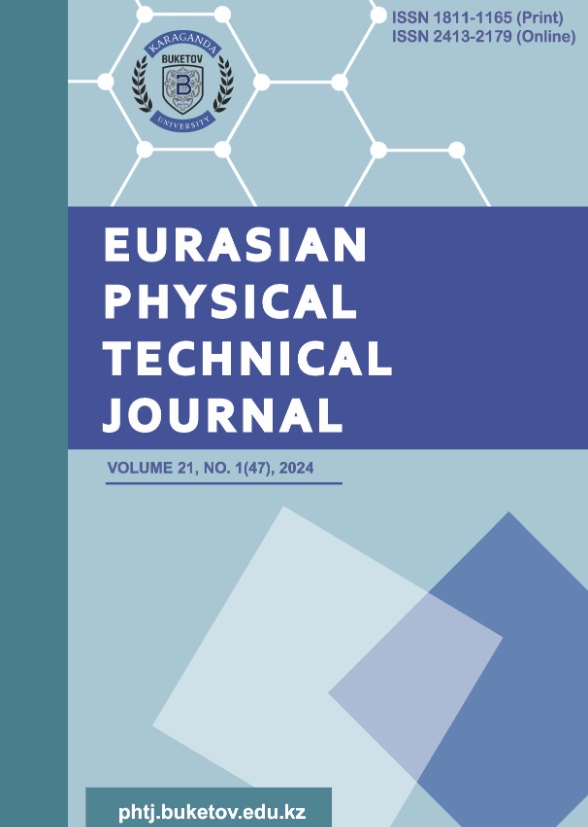Аморфты гидрогенизацияланған кремний мысалында күрделі беттердің рельефіндегі корреляцияларды зерттеу
DOI:
https://doi.org/10.31489/2024No1/6-13Аңдатпа
Scale-space әдістемесінің көмегімен құрылымдық құраушыларын оқшаулау жолымен жою трендімен орташа өзара ақпарат әдісімен және екі өлшемді флуктуациялық талдау әдісімен аморфты гидрогенизацияланған кремнийдің беттік рельефіндегі корреляцияны зерттеу нәтижелері ұсынылған. Эксперименттік үлгілер аморфты гидрогенизацияланған кремнийдің модельдік және нақты беттері болып табылды. Модель беті «Стохастикалық фрактал», «Бөлшектер» және «Гаусс шуы» беттерін қабаттастыру арқылы құрылды. Флуктуациялық функцияның масштабқа тәуелділігінен есептелген скейлинг көрсеткішінің мәндері, сондай-ақ орташа өзара ақпарат пен максималды өзара ақпараттың мәндері анықталды. Аморфты гидрогенизацияланған кремнийдің модельдік және нақты беттерінің корреляциялық тәуелділіктерінің салыстырмалы талдауы эксперименттік үлгінің беттік құрылымына «Бөлшек» модельдік бетінің сипаттамалары бойынша ең жақын екенін көрсетті. Эксперименттік үлгінің беткі құрылымында өлшемдері 65±10 нм болатын бөлшектер бар екендігі анықталды.
References
Popov A.I. Physics and technology of disordered semiconductors. Moscow, Publishing house MPEI, 2008, 270 p. https://books.google.ru/books?id=17P2RAAACAAJ&hl=ru&source=gbs_navlinks_s [in Russian].
Golikova O.A. Average order and optoelectronic properties of a tetrahedrally coordinated hydrogenated amorphous semiconductor. Physics and Technology of Semiconductors, 2001, Vol. 35, No. 11, pp. 1370-1375. https://journals.ioffe.ru/articles/38663 [in Russian].
Takens F. Detecting strange attractors in turbulence. Dynamical Systems and Turbulence, 1980, Vol. 989, pp. 366-381. https://link.springer.com/chapter/10.1007/BFb0091924
Mursalov S.M., Bodyagin N.V., Vikhrov S.P. On the calculation of correlations in the structure of surfaces of solid-state materials. Letters to the Journal of Technical Physics, 2000, Vol. 26, No. 15, pp. 53-57. https://journals.ioffe.ru/articles/37864 [in Russian]
Avacheva T.G., Bodyagin N.V., Vikhrov S.P., Mursalov S.M. Study of self-organization in disordered materials using information theory. Semiconductors, 2008, Vol. 42, No. 5, pp. 499-504. https://doi.org/10.1134/S1063782608050011
Witkin A.P. Scale-Space Filtering. Readings in Computer Vision: Issues, Problem, Principles, and Paradigms, 1987, pp. 329-332. https://doi.org/10.1016/b978-0-08-051581-6.50036-2
Alpatov A.V., Rybina N.V. Application of the scale-space methodology to the study of self-organizing structures. Surface. X-ray, Synchrotron and Neutron Studies, 2019, No. 7, pp. 92-98. https://doi.org/10.1134/s0207352819050032 [in Russian]
Rybina N.V., Rybin N.B., Vikhrov S.P. Classification of the degree of self-organization of the relief of thin-film structures using 2D DFA and AMI methods. Bulletin of the Ryazan State Radio Engineering University, 2017, Vol.61, No. 3, pp. 143-151. https://doi.org/10.21667/1995-4565-2017-61-3-143-151 [in Russian]
Golodenko A.B. Assessment of the adequacy of the fractal model of the atomic structure of amorphous silicon. Physics and Technology of Semiconductors, 2010, Vol. 44, No.1, pp. 87-91. https://journals.ioffe.ru/articles/7031 [in Russian]
Voyles P.M., Abelson J.R. Medium-range order in amorphous silicon measured by fluctuation electron microscopy. Solar Energy Materials & Solar Cells, 2003, Vol. 78, No. 1, pp. 85-114. https://doi.org/10.1016/S0927- 0248(02)00434-8
Downloads
Түсті
Өңделді
Қабылданды
Жарияланды
How to Cite
Журналдың саны
Бөлім
License

This work is licensed under a Creative Commons Attribution-NonCommercial-NoDerivatives 4.0 International License.













